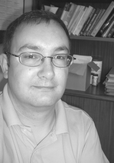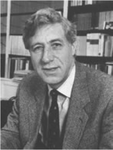Ion–radical salts: a new type of molecular ferrimagnet
Scott S.
Turner
a and
Peter
Day
*b
aChemistry Department, University of Exeter, Stocker Road, Exeter, EX4 4QD, UK. E-mail: S.S.Turner@exeter.ac.uk
bDavy-Faraday Research Laboratory, The Royal Institution, 21 Albemarle Street, London W1S 4BS, UK. E-mail: pday@ri.ac.uk
First published on 26th November 2004
Abstract
Long-range ferrimagnetic order in which one magnetic sub-lattice is formed from partly-occupied p-orbitals and the other from d-orbitals can be achieved in molecular ion–radical salts where the cations are oxidised organo-chalcogen donors and the anions are 3d-metal complexes containing both N-bonded NCS and planar N-heterocyclic ligands. Overlaps between p-orbitals of the radical cations and those of the heterocycle are implicated in the cation–anion exchange pathway.
 Scott Turner | Scott Turner received a BSc (1990) in chemistry and PhD (1993) in inorganic chemistry from the University of Manchester, UK. His doctoral studies were undertaken with Dr F. Mabbs in the field of the EPR spectroscopy of oligomeric vanadyl species. Subsequently he joined the group of the late Prof. O. Kahn, in Paris and then Bordeaux, as a NATO research fellow for two years. During this time he worked on a wide variety of molecule-based magnetic materials. From 1996 to 2004 he worked with Prof. Day as a post-doctoral researcher, synthesising and characterising novel molecule-based conductors and magnets. Recently Dr Turner has become a lecturer of Inorganic Chemistry at the University of Exeter, UK. His current research activities focus on bistable and multifunctional molecule-based conductors. |
 Peter Day. | Peter Day gained his first degree and DPhil in inorganic chemistry from Oxford University, where he was subsequently Departmental Demonstrator, University Lecturer and Ad Hominem Professor of Solid State Chemistry, and a Fellow of St. John's College. From 1988–1991 he was Director of the Institut Laue-Langevin, Grenoble, the European neutron scattering centre and from 1991–1998, Director of the Royal Institution in London and its Davy-Faraday Research Laboratory, where he remains Fullerian Professor of Chemistry. He was elected FRS in 1986 and, in addition to numerous awards from the Royal Society of Chemistry and the Royal Society, he holds honorary doctorates from the Universities of Newcastle and Kent, and Honorary Fellowships of St. John's and Wadham Colleges, Oxford, and University College, London. His research interests have long centred on the synthesis and electronic properties of molecular organic and metal–organic solids. From 1998–2002 he was Scientific Advisory Editor of the Journal of Materials Chemistry. |
When Néel1 published his seminal theoretical paper defining the characteristics of ferrimagnets in 1948, he envisaged that the localised atomic moments making up the two antiferromagnetically coupled sub-lattices would be furnished by partly-filled d-shells. Specifically, he had in mind spinels AB2O4 where A is a 2+ and B a 3+ transition-metal ion. Since then, hundreds (if not thousands) of ferrimagnetic phases have been prepared and characterised, based not only on d- but also on f-atomic moments2 but, until quite recently, no three-dimensional examples were known where one of the magnetic sub-lattices consisted of moments originating from partly-filled p-shells. The reason for this deficiency is obvious: paramagnetic p-electron systems are normally highly reactive and immediately combine with one another to form dimers and polymers, hence losing the magnetism in electron-pair bonds.
The proliferation of ion–radical salts (Dn)+(X)− over the last 20 years might be useful in addressing this problem because they are formed by oxidising an aromatic donor molecule D to a radical cation and stabilising it in a crystal lattice through combining it with an anion, X.3 However, in the vast majority of cases, overlap between p-orbitals of neighbouring (Dn)+ is great enough to form a conduction band (albeit usually a narrow one) so the resulting solid is a strongly-correlated metal or a semiconductor.4 Indeed, most of the presently known organic superconductors are drawn from the families of ion–radical salts based on organo-chalcogen donors like TMTSF (tetramethyl tetraselenofulvalene)5 and BEDT–TTF (bis-ethylenedithiotetrathiafulvalene).6 To make molecular ion–radical salts that show long-range magnetic order rather than coherent electron transport, we must therefore use crystal engineering principles to devise structures that inhibit D⋯D overlap. Furthermore, to make bulk ferrimagnets where one sub-lattice is formed from p-electrons and the other from d-electrons, we also need to enhance D⋯X overlap, while incorporating the d-moments into X. Those requirements have now been fulfilled in the family of compounds described below.
The ion–radical salts of TTF-type donors are good conductors because strong non-covalent S⋯S interactions enhance the inter-molecular D⋯D transfer integrals. We therefore used the same strategy to build up D⋯X interactions by synthesising salts in which X also contains S or Se. An obvious point of departure is the NCS ligand, bound to 3d-metal ions through N, with the S able to interact with the TTF. Indeed, salts such as (BEDT–TTF)4[M(NCS)6].CH2Cl2 (M = Cr, Fe) do show numerous close cation–anion S⋯S contacts and the closely-knit layers of donor molecules characteristic of BEDT–TTF salts are substantially disrupted.7 On the other hand, however, they behave as almost perfect paramagnets, obeying the Curie–Weiss law down to 2 K (e.g. for M = Fe, the Weiss constant is −0.19 K). It appears that S⋯S interactions are not sufficient to induce significant D⋯X exchange.
Fortunately all is not lost, as there exist a large class of paramagnetic anions based on Reinecke's salt, first synthesised over 100 years ago.8 In these, two of the NCS ligands are replaced by aliphatic or aromatic amines B, yielding cis- or trans-[M(NCS)4B2]−. When B = NH3 there is still no detectable D⋯X interaction (e.g. in (BEDT–TTF)2[Cr(NCS)4(NH3)2] the Weiss constant is less than 0.1 K9) but for B = isoquinoline and 1,10-phenanthroline (phen), long-range ferrimagnetic order is established between 6 and 9 K.10 A typical example is (BEDT-TTF)[Cr(NCS)4(isoquinoline)2]. The crystal structure (Fig. 1) contains many S⋯S contacts between D and X but, more importantly, π–π overlaps between D+ and the isoquinoline.11 The magnetic susceptibility (Fig. 2) is typical of a ferrimagnet, with a minimum in χT indicating antiferromagnet ic near-neighbour exchange between the D+ (S = 1/2) and X− (S = 3/2) sub-lattices.10
![Crystal structure of (BEDT-TTF)[Cr(NCS)4(iso-quinoline)2].11](/image/article/2005/JM/b412696n/b412696n-f1.gif) | ||
| Fig. 1 Crystal structure of (BEDT-TTF)[Cr(NCS)4(iso-quinoline)2].11 | ||
![Temperature dependence of magnetic susceptibility for (BEDT-TTF)[Cr(NCS)4(iso-quinoline)2].10 Open circle, right-hand scale; filled squares, left hand scale. Inset is an enlargement of the 6–20 K region.](/image/article/2005/JM/b412696n/b412696n-f2.gif) | ||
| Fig. 2 Temperature dependence of magnetic susceptibility for (BEDT-TTF)[Cr(NCS)4(iso-quinoline)2].10 Open circle, right-hand scale; filled squares, left hand scale. Inset is an enlargement of the 6–20 K region. | ||
However, the structurally simplest example is (TTF)[Cr(NCS)4(phen)] (Fig. 3),12 which has the further advantage that the larger quantities needed for detailed physical studies can be obtained by metathesis rather than electrochemical oxidation.13Fig. 4 shows the AC susceptibility of this phase, indicating a Tc of 8.3 K.13 Recently this class of ferrimagnets has been enlarged further by reports of analogous salts of tetramethyl-TTF14 and of non-TTF organo-sulfur donors.15
![Crystal structure of (TTF)[Cr(NCS)4(phen)].12](/image/article/2005/JM/b412696n/b412696n-f3.gif) | ||
| Fig. 3 Crystal structure of (TTF)[Cr(NCS)4(phen)].12 | ||
![Temperature dependence of AC susceptibility of per-deuterated (TTF)[Cr(NCS)4(phen)] at 10 kHz.13 Full circles, in-phase; empty circles, out-of-phase signals.](/image/article/2005/JM/b412696n/b412696n-f4.gif) | ||
| Fig. 4 Temperature dependence of AC susceptibility of per-deuterated (TTF)[Cr(NCS)4(phen)] at 10 kHz.13 Full circles, in-phase; empty circles, out-of-phase signals. | ||
Finally, although the concept of a simple π–d ferrimagnet, based on an ion–radical salt is undoubtedly attractive, this family may be more complicated than appears at first sight. For example, the first muon spin rotation measurements on such salts reveal, surprisingly, that in addition to the ordering transition at 8.3 K in (TTF)[Cr(NCS)4(phen)], there is a further transition at 2 K,16 also evident in the heat capacity.17 Likewise the first electronic structure calculations on this class of salt suggest that the S⋯S contacts contribute more than the π–π ones to the inter-molecular exchange, in contrast to the empirical finding that cation–anion S⋯S contacts alone are not enough to engender long-range ferromagnetic order at accessible temperatures.18 So there remains much more to learn about ion–radical salts as π–d ferrimagnets.
Acknowledgements
The work summarised here was supported by the UK Engineering and Physical Sciences Research Council and the European Commission (TMR Network on Molecular Magnetism and COST Action D14).References
- L. Néel, Ann. Phys. (Paris), 1948, 1, 137 Search PubMed.
- See e.g.J. B. Goodenough, Magnetism and the Chemical Bond, Interscience, New York, 1963, passim. Search PubMed.
- See e.g.J. M. Williams, J. R. Ferraro, R. J. Thorn, K. D. Carlson, U. Geiser, H. H. Wang, A. M. Kini and M-H. Wangbo, Organic Superconductors (including Fullerenes): Synthesis, Structure, Properties and Theory, Prentice-Hall, New York, 1992 Search PubMed.
- T. Ishiguro, K. Yamaji and G. Saito, Organic Superconductors, Springer, Berlin, 1998 Search PubMed; J. Singleton, Rep. Prog. Phys., 2000, 63, 1111 Search PubMed.
- D. Jerome, A. Mazaud, M. Ribault and K. Bechgaard, J. Phys. Lett., 1980, 41, L95 Search PubMed.
- H. Urayama, H. Yamochi, G. Saito, S. Sato, A. Kawamoto, J. Tanaka, T. Mori, Y. Maruyama and H. Inokuchi, Chem. Lett., 1988, 463 CAS.
- S. S. Turner, P. Day, T. Gelbrich and M. B. Hursthouse, J. Solid State Chem., 2001, 159, 385 CrossRef CAS; S. S. Turner, D. Le Pevelen, P. Day and C. K. Prout, J. Solid State Chem., 2002, 168, 573 CrossRef CAS.
- O. T. Christensen, J. Prakt. Chem., 1892, 45, 213, 356; Handbuch Präparativen Anorganischen Chemie, ed. G. Brauer, Ferdinand Enke Verlag, Stuttgart, 3rd edn., 1975–1981, vol. 3, p. 1516 Search PubMed.
- C. J. Kepert, M. Kurmoo and P. Day, J. Chem. Soc., Dalton Trans., 1997, 607 RSC.
- S. S. Turner, C. Michaut, P. Durot, P. Day, T. Gelbrich and M. B. Hursthouse, J. Chem. Soc., Dalton Trans., 2000, 905 RSC.
- F. Setifi, S. Golhen, L. Ouahab, S. S. Turner and P. Day, Cryst. Eng. Commun., 2002, 4, 1 RSC.
- S. S. Turner, D. Le Pevelen, P. Day and C. K. Prout, J. Chem. Soc., Dalton Trans., 2000, 2739 RSC; D. Le Pevelen, S. S. Turner, P. Day and C. K. Prout, Synth. Met., 2001, 120, 1842 CrossRef.
- S. S. Turner, S. G. Carling, P. Day, C. J. Gomez-Garcia and E. Coronado, J. Phys. IV, 2004, 114, 585 Search PubMed.
- M. Mas-Torrent, S. S. Turner, K. Wurst, J. Vidal-Ganecdo, X. Ribas, J. Veciana, P. Day and C. Rovira, Inorg. Chem., 2003, 42, 7544 CrossRef CAS.
- F. Setifi, S. Golhen, L. Ouahab, A. Miyazaki, K. Okabe, T. Enoki, T. Toita and J. Yamada, Inorg. Chem., 2002, 41, 3786 CrossRef CAS; F. Setifi, S. Golhen, L. Ouahab, A. Miyazaki, T. Enoki and J. Yamada, C. R. Chim., 2003, 6, 309 Search PubMed.
- P. Day, S. G. Carling, S. S. Turner, J. Bradley, D. Hautot and D. Visser, ISIS Annual Report (Science Highlights), CLRC Rutherford Appleton Laboratory, Didcot, Oxfordshire, 2003, p. 8 Search PubMed.
- C. J. Gomez-Garcia, S. S. Turner, E. Coronado and P. Day, to be published.
- T. Mori and M. Katshuhara, J. Phys. Soc. Jpn., 2003, 72, 149 CrossRef CAS.
| This journal is © The Royal Society of Chemistry 2005 |
